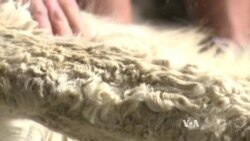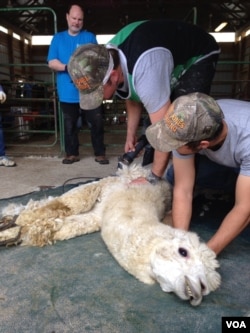ADAMSTOWN, MARYLAND —
It’s shearing season at Sugarloaf Farm just outside Washington, where most of the alpacas don't seem to mind getting a haircut.
But whether they like it or not, the 130 animals will have their woolly fleece sheared. It will keep them from getting overheated during the summer months while generating a cool profit for farm owner Kevin Brandt.
“We’re finding that there are more people in the marketplace looking for alpaca yarns because it’s considered to be hypoallergenic, and it’s really as soft as cashmere,” he said.
Fleece quality
Brandt keeps both types of alpacas at his farm; the Huacaya and the Suri.
“The Suri has the long, dreadlock-like fiber and the Huacaya has the fluffy, teddy bear style,” he said.
The animals provide three different grades of fleece.
The finest comes from the animals’ back, hip and shoulder and is usually made into clothing. The next-best grade comes from the neck.
The third-grade fleece, from the legs and belly, is a coarser fiber that is used for rugs and accessories.
Spinning mill
Brandt and his team process the raw fleece into yarn in a spinning mill right on the grounds of his farm.
The first step is the tumbler, a big machine which removes loose dirt and debris from the fiber. The fiber is then washed and dried and put through the picker to further separate the fibers.
It’s then ready for a machine which aligns and blends it with other fibers. Another machine thins and lengthens the fiber. The spinner is where it finally becomes a single ply of yarn.
After a few more steps, the final product is ready for sale, either in its natural form, or kettle dyed in various colors.
Alpaca sales
Brandt sells those varieties of yarn, along with other ready-made alpaca products, in his store on the farm’s grounds.
And that isn’t the only source of income on the farm.
“We raise and sell alpacas as bred females. We also sell pet males and fiber males to others. We also have a stud service where we’ll take our stud males around for hire,” Brandt said.
He proudly showed off Charmer, one of the most popular studs at the farm, who appeared very comfortable with all the attention.
Happy accident
Brandt, who has owned the farm for about 10 years, got into the alpaca business almost by accident.
“My wife Nancy and oldest daughter and I were at the local country fair and we decided to stop into one more barn before we went home and it happened to be the alpaca barn and almost instantly we fell in love with the alpacas,” he said.
Alpacas are part of the camel family. They are curious by nature and easy to care for. There are more than 300,000 alpacas in the U.S., but no more are being imported since a ban was imposed in 1993.
“Alpaca are just a wonderful livestock,” said Brandt, “They’re gentle. We’ve raised our three kids here and it’s a wonderful lifestyle to have.”
And as more and more people learn about the joy ‒ and income potential ‒ alpacas can bring, he anticipates even more farms like his springing up in the future.
But whether they like it or not, the 130 animals will have their woolly fleece sheared. It will keep them from getting overheated during the summer months while generating a cool profit for farm owner Kevin Brandt.
“We’re finding that there are more people in the marketplace looking for alpaca yarns because it’s considered to be hypoallergenic, and it’s really as soft as cashmere,” he said.
Fleece quality
Brandt keeps both types of alpacas at his farm; the Huacaya and the Suri.
“The Suri has the long, dreadlock-like fiber and the Huacaya has the fluffy, teddy bear style,” he said.
The animals provide three different grades of fleece.
The finest comes from the animals’ back, hip and shoulder and is usually made into clothing. The next-best grade comes from the neck.
The third-grade fleece, from the legs and belly, is a coarser fiber that is used for rugs and accessories.
Spinning mill
Brandt and his team process the raw fleece into yarn in a spinning mill right on the grounds of his farm.
The first step is the tumbler, a big machine which removes loose dirt and debris from the fiber. The fiber is then washed and dried and put through the picker to further separate the fibers.
It’s then ready for a machine which aligns and blends it with other fibers. Another machine thins and lengthens the fiber. The spinner is where it finally becomes a single ply of yarn.
After a few more steps, the final product is ready for sale, either in its natural form, or kettle dyed in various colors.
Alpaca sales
Brandt sells those varieties of yarn, along with other ready-made alpaca products, in his store on the farm’s grounds.
And that isn’t the only source of income on the farm.
“We raise and sell alpacas as bred females. We also sell pet males and fiber males to others. We also have a stud service where we’ll take our stud males around for hire,” Brandt said.
He proudly showed off Charmer, one of the most popular studs at the farm, who appeared very comfortable with all the attention.
Happy accident
Brandt, who has owned the farm for about 10 years, got into the alpaca business almost by accident.
“My wife Nancy and oldest daughter and I were at the local country fair and we decided to stop into one more barn before we went home and it happened to be the alpaca barn and almost instantly we fell in love with the alpacas,” he said.
Alpacas are part of the camel family. They are curious by nature and easy to care for. There are more than 300,000 alpacas in the U.S., but no more are being imported since a ban was imposed in 1993.
“Alpaca are just a wonderful livestock,” said Brandt, “They’re gentle. We’ve raised our three kids here and it’s a wonderful lifestyle to have.”
And as more and more people learn about the joy ‒ and income potential ‒ alpacas can bring, he anticipates even more farms like his springing up in the future.








